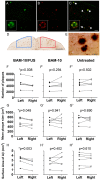Antibodies targeted to the brain with image-guided focused ultrasound reduces amyloid-beta plaque load in the TgCRND8 mouse model of Alzheimer's disease
- PMID: 20485502
- PMCID: PMC2868024
- DOI: 10.1371/journal.pone.0010549
Antibodies targeted to the brain with image-guided focused ultrasound reduces amyloid-beta plaque load in the TgCRND8 mouse model of Alzheimer's disease
Abstract
Immunotherapy for Alzheimer's disease (AD) relies on antibodies directed against toxic amyloid-beta peptide (Abeta), which circulate in the bloodstream and remove Abeta from the brain. In mouse models of AD, the administration of anti-Abeta antibodies directly into the brain, in comparison to the bloodstream, was shown to be more efficient at reducing Abeta plaque pathology. Therefore, delivering anti-Abeta antibodies to the brain of AD patients may also improve treatment efficiency. Transcranial focused ultrasound (FUS) is known to transiently-enhance the permeability of the blood-brain barrier (BBB), allowing intravenously administered therapeutics to enter the brain. Our goal was to establish that anti-Abeta antibodies delivered to the brain using magnetic resonance imaging-guided FUS (MRIgFUS) can reduce plaque pathology. To test this, TgCRND8 mice received intravenous injections of MRI and FUS contrast agents, as well as anti-Abeta antibody, BAM-10. MRIgFUS was then applied transcranially. Within minutes, the MRI contrast agent entered the brain, and BAM-10 was later found bound to Abeta plaques in targeted cortical areas. Four days post-treatment, Abeta pathology was significantly reduced in TgCRND8 mice. In conclusion, this is the first report to demonstrate that MRIgFUS delivery of anti-Abeta antibodies provides the combined advantages of using a low dose of antibody and rapidly reducing plaque pathology.
Conflict of interest statement
Figures




References
-
- Weiner HL, Frenkel D. Immunology and immunotherapy of Alzheimer's disease. Nat Rev Immunol. 2006;6:404–416. - PubMed
-
- Hawkes CA, McLaurin J. Immunotherapy as treatment for Alzheimer's disease. Expert Rev Neurother. 2007;7:1535–1548. - PubMed
-
- Hynynen K, McDannold N, Vykhodtseva N, Jolesz FA. Noninvasive MR imaging-guided focal opening of the blood-brain barrier in rabbits. Radiology. 2001;220:640–646. - PubMed
Publication types
MeSH terms
Substances
Grants and funding
LinkOut - more resources
Full Text Sources
Other Literature Sources
Medical
Miscellaneous

